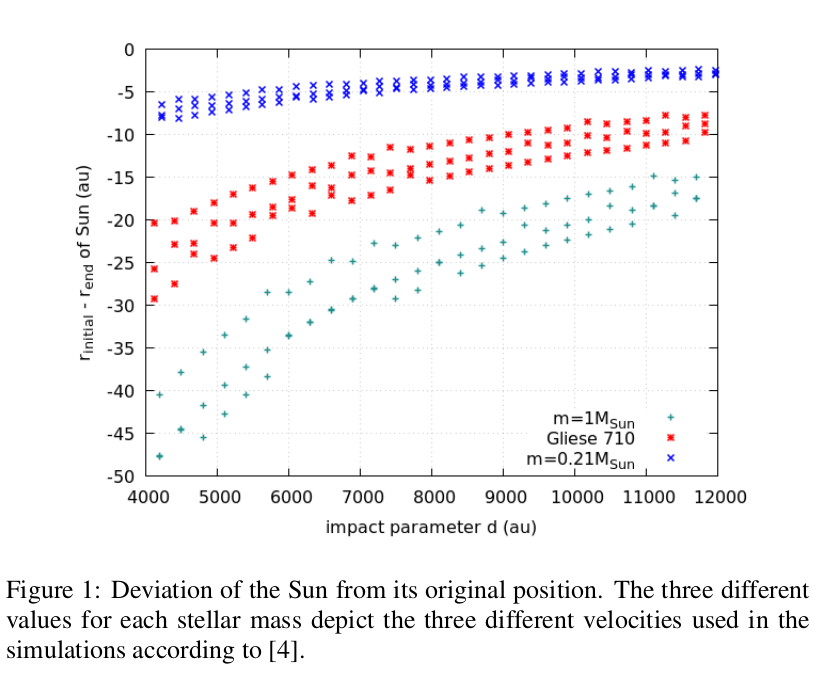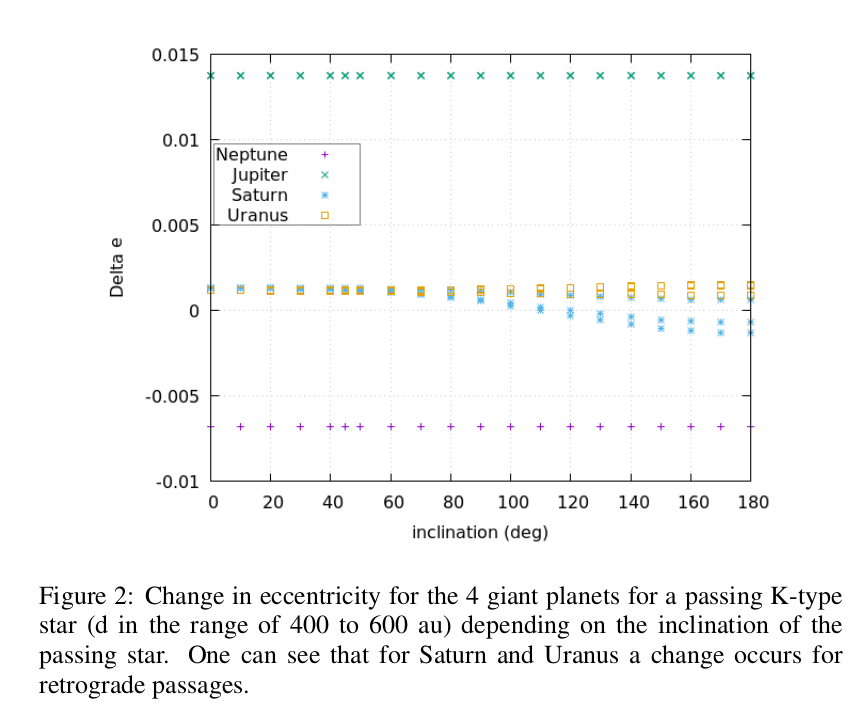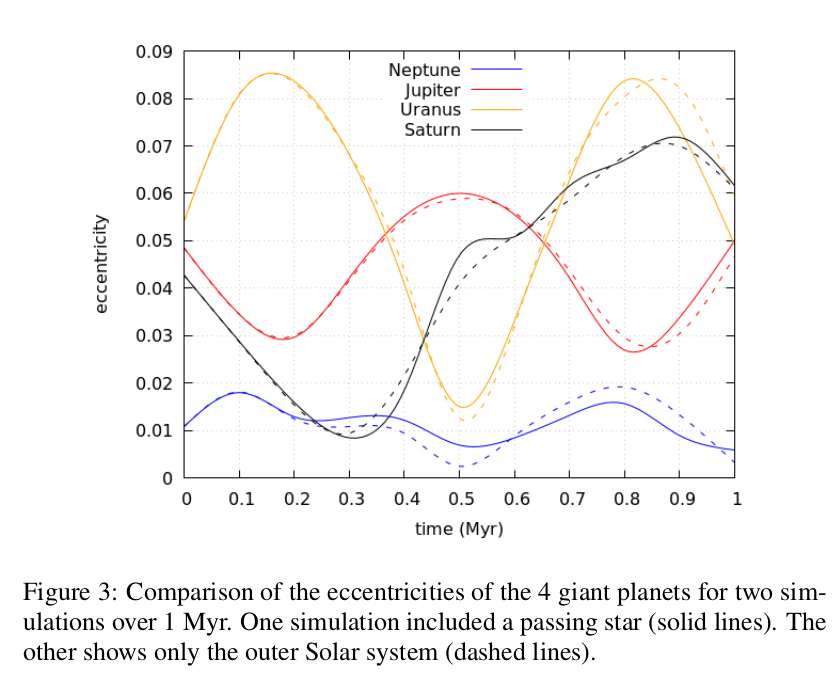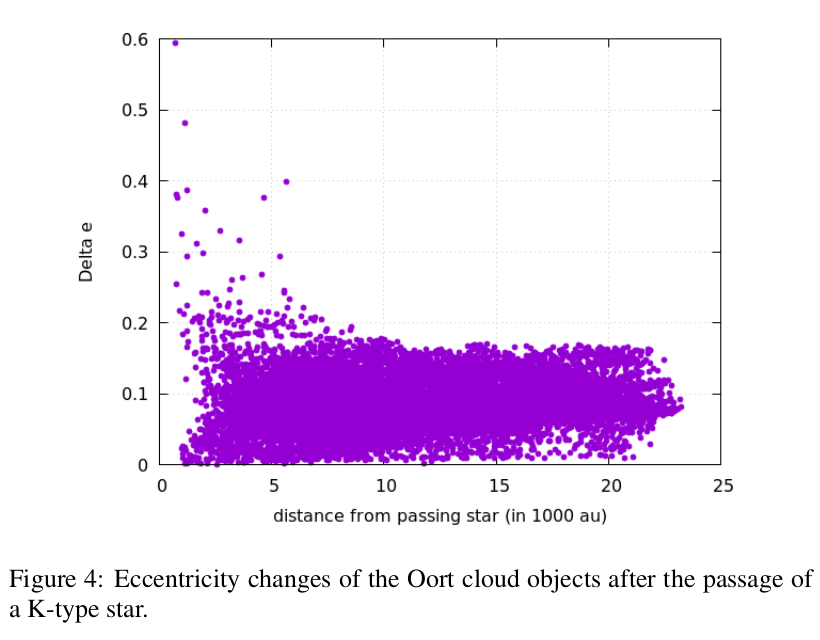Influence of stellar flyby events on planetary systems
- University of Vienna, Institute of Astrophysics, Vienna, Austria (birgit.loibnegger@univie.ac.at)
Abstract
Stars passing close by the Sun experience a change of their trajectory due to gravitational interaction -- which also changes the trajectory of the Sun around the galactic center. In this study we show possible changes for the outer Solar system caused by the future flyby of Gliese 710 considering various inclinations of the passing star.
Introduction
Most stars are born in clusters. Gravitational interactions between the cluster members can have significant influence on the planet formation process and small body distributions [2]. Even after having left the cluster flybys with other stars can happen. The Sun will experience such a flyby in about 1.36 Myr. Gliese 710 (a K-type star) will probably pass inside of the Oort cloud [1]. This motivated us to investigate the influence of passing stars on the trajectory of the Sun as well as on the orbits of the gas planets [3,5] and Oort cloud objects. The stellar flyby has been carried out for different stellar types (M -- G-type stars) with different encounter velocities [4] as well as different impact parameters and different inclinations of the passing star.
Setup and Method
The setup uses the outer Solar system including the Sun, the 4 giant planets (Jupiter, Saturn, Uranus, and Neptune), Oort cloud comets, and a passing star. The passing star initially moves on a straight line passing the Sun at a certain distance (i.e., impact parameter d). The ranges for the parameters are summed up as follows:
- Mass of passing star: 0.21 MSun, 0.6 MSun (i.e., Gliese710), and 1 MSun
- Impact parameter: d between 4000 and 12000 au (estimated area of Gliese 710 flyby [1] -- see figure 1) and for closer flybys (e.g., 400 to 600 au -- see figure 2)
- Velocity of the passing star: taken from [4]: v - σv , v , v + σv -- see figure 1
The numerical simulations were carried out using the newly developed N-body package [6], i.e., a parallelized GPU-N-body code designed to handle the gravitational interaction of up to 10000 massive particles. Each stellar flyby was integrated for about 30000 yrs where both the initial and the final position of the passing star were 100000 au away from the Sun.
Results

The results show a distinct bend in the trajectory of the passing stars at the point of closest approach to the Sun. Vice versa the Sun is diverted from its original trajectory, too. Figure 1 shows how much a passing star influences the Sun's path. The Sun might be diverted by up to 30 au by a K-type star. For impact parameters larger than 12000au the diversion is smaller than 20au even for a passing G-type star.
An analysis of the orbits of the 4 giant planets after an inclined flyby shows that for retrograde passages of a K-type star the eccentricity for Saturn is decreased. For Uranus the eccentricity increases for inclinations bigger than 80° -- see figure 2.

For a passing G-type star at d = 600 au with 0° inclination the long term changes in the eccentricities of the 4 giant planets are depicted in figure 3.

The scattering of Oort cloud objects by a passing star with d=12000au, M=0.6MSun (Gliese 710), and inclination of 0° is depicted in figure 4. Objects in the vicinity of the passage (up to 4000 au distance from the passing star) get scattered the strongest. A change in eccentricty is possible up to 0.6. If Gliese 710 passes at 4000 au, we assume that also Kuiper belt objects can be perturbed. Additionally, we assume that in the inner Oort cloud there are more objects than in the outer cloud (used in our integrations) thus more objects might get scattered inwards.

Summary and Conclusions
We showed that the orbit of the Sun around the galactic center can be altered depending on the properties of the passing star (mass, velocity, impact parameter). This can slightly change change its orbit in the Milky Way.
Our study for the outer Solar system shows only small perturbations of the eccentricities of the planetary orbits. Only inclinations of the passing star larger than 80° show some changes of the orbits of Uranus and Saturn. These small perturbations could influence the orbital behaviour and will be studied in more detail. In this context figure 3 shows slight deviations of the planetary eccentricities after a stellar passage with inclination of 0°. The changes of the orbits are only visible in the long time computation.
Short time changes are visible in the orbits of Oort cloud objects which experience the close flyby of a star.
Acknowledgements
This research was funded in whole by the Austrian Science Fund (FWF) [P33351-N].
References
[1] Bailer-Jones C.~A.~L.: New stellar encounters discovered in the second Gaia data release; A$\&$A, 616, A37, 2018.
[2] Bancelin D., Nordlander T., Pilat-Lohinger E., Loibnegger B.: Dynamics of passing-stars-perturbed binary star systems; MNRAS, 486, 4, 4773-4780, 2019.
[3] Innanen K.~A., Zheng J.~Q, Mikkola S., Valtonen M.~J.: The Kozai Mechanism and the Stability of Planetary Orbits in Binary Star Systems; AJ, 113, 1915, 1997.
[4] Rickman H., Fouchard M., Froeschl{\'e} C., Valsecchi G.~B.: Injection of Oort Cloud Comets: The Fundamental Role of Stellar Perturbations; Asteroids, Comets, Meteors 2008, LPICo, 1405, 8077, 2008.
[5] Tanikawa K., Ito T.: Subsystems in a Stable Planetary System; PASJ, 59, 989, 2007.
[6] Zimmermann M.: The influene of binary systems on planetesimal disks. Master thesis, University of Vienna, 2021.
How to cite: Loibnegger, B., Pilat-Lohinger, E., Zimmermann, M., and Clees, S.: Influence of stellar flyby events on planetary systems, Europlanet Science Congress 2021, online, 13–24 Sep 2021, EPSC2021-672, https://doi.org/10.5194/epsc2021-672, 2021.

